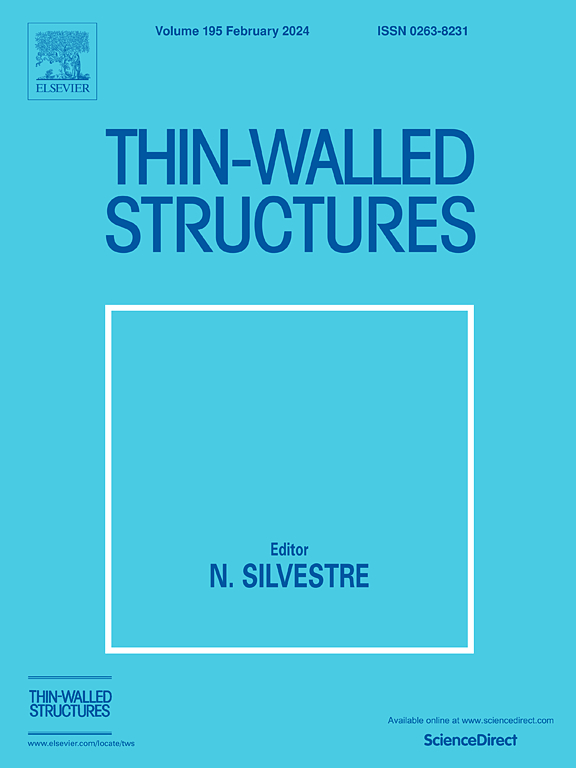模块化钢结构建筑倒塌行为比较研究:实验与分析
IF 5.7
1区 工程技术
Q1 ENGINEERING, CIVIL
引用次数: 0
摘要
随着越来越多地采用模块化建筑技术,了解模块化钢结构建筑的倒塌机理变得至关重要。本研究介绍了两种模块化钢结构下部结构的倒塌对比试验:角柱损失试样(S-CCL)和侧柱损失试样(S-SCL)。比较了模块的破坏模式、承载能力、横向位移、双层梁的相对滑移以及组件的变形机制。研究结果表明,在两种试样中,远离支柱损失区域的模块梁端部都出现了明显的屈曲,而在支柱损失区域附近则出现了轻微的屈曲。在 S-CCL 中未观察到螺栓孔断裂,而 S-SCL 则表现出明显的断裂。在弹性阶段,S-SCL 的承载能力约为 S-CCL 的两倍,在弹塑性阶段,由于导管作用,承载能力进一步提高,最终达到 S-CCL 的三倍。只有在 S-SCL 的双跨梁方向上才会出现明显的横向位移,即向支柱损耗区方向位移,而在其他方向上,位移较小,而且是向远处位移。数字图像相关测量(DIC)表明,与 S-CCL 相比,S-SCL 双层梁的相对滑移要小得多。应变仪读数显示,两个模块的柱子都保持在弹性范围内,但 S-SCL 中的柱子在塑性阶段继续变形,这是由于连接梁中的拉力造成的,远离柱子损失区域的梁端出现负弯矩。本文章由计算机程序翻译,如有差异,请以英文原文为准。
Comparative study on collapse behavior of modular steel buildings: Experiment and analysis
With the increasing adoption of modular construction technology, understanding the modular steel buildings' collapse mechanisms has become crucial. This study presents comparative collapse tests on two modular steel substructures: specimen in corner column loss (S-CCL) and specimen in side column loss (S-SCL). The failure modes, load-bearing capacities, lateral displacements of modules, relative slips of double-layer beams, and deformation mechanisms of the components were compared. The findings reveal significant buckling at the ends of module beams far from the column loss area in both specimens, with minor buckling near the column loss area. No bolt hole fracture is observed in S-CCL, while S-SCL exhibits clear fractures. S-SCL demonstrates approximately double the load-bearing capacity of S-CCL during the elastic stage, and this increases further in the elastoplastic stage due to catenary action, ultimately reaching three times that of S-CCL. Significant lateral displacement occurs only in the double-span beam direction of S-SCL, towards the column loss area, while in other directions, displacement is minor and directed away. Digital image correlation (DIC) measurements indicate that relative slip in double-layer beams is significantly smaller in S-SCL compared to S-CCL. Strain gauge readings show that both module columns remain within the elastic range, but columns in S-SCL continue to deform in the plastic stage due to tensile forces in the connected beams, with beam ends away from the column loss area experiencing negative bending moments.
求助全文
通过发布文献求助,成功后即可免费获取论文全文。
去求助
来源期刊

Thin-Walled Structures
工程技术-工程:土木
CiteScore
9.60
自引率
20.30%
发文量
801
审稿时长
66 days
期刊介绍:
Thin-walled structures comprises an important and growing proportion of engineering construction with areas of application becoming increasingly diverse, ranging from aircraft, bridges, ships and oil rigs to storage vessels, industrial buildings and warehouses.
Many factors, including cost and weight economy, new materials and processes and the growth of powerful methods of analysis have contributed to this growth, and led to the need for a journal which concentrates specifically on structures in which problems arise due to the thinness of the walls. This field includes cold– formed sections, plate and shell structures, reinforced plastics structures and aluminium structures, and is of importance in many branches of engineering.
The primary criterion for consideration of papers in Thin–Walled Structures is that they must be concerned with thin–walled structures or the basic problems inherent in thin–walled structures. Provided this criterion is satisfied no restriction is placed on the type of construction, material or field of application. Papers on theory, experiment, design, etc., are published and it is expected that many papers will contain aspects of all three.
 求助内容:
求助内容: 应助结果提醒方式:
应助结果提醒方式:


